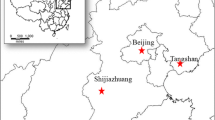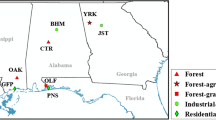Abstract
The Po Valley stands out as one of the most urbanized and industrialized regions in Europe. For decades, it has been grappling with the impact of human exposure to fine particulate matter (PM2.5). The Lombardy Region in northern Italy, a key area within the Po Valley, experiences a complex interplay of main emission precursors (NH3, NOx, and SOx), leading to the formation of secondary inorganic aerosols. In this paper, we investigate the effects of reducing NH3, NOx, and SOx emissions, individually and in combination, on PM2.5 concentrations in the Lombardy Region. Our analyses employ the operational Air Quality model, used daily by ARPA Lombardia. The focus of the study is wintertime period (1 January–31 March), recognized as the most challenging period of the year due to strong correlations between NH3, PM10, (NH4)NO3, and (NH4)2SO4 concentrations and peaking days of ammonia emissions from slurry spreading. Our results reveal that, during wintertime emission reductions, (a) PM2.5 concentration changes exhibit linearity within 25% reduction of precursors, with non-linearities increasing as precursors reductions surpass this threshold; (b) the NOx-sensitive areas extend spatially up to 50% reductions and localize in areas with higher NH3 emissions; (c) NH3-sensitive areas are concentrated in densely urbanized regions of the Lombardy Region; and (d) sensitive chemical regimes are mixed, and it is more effective to reduce both NH3 and NOx rather than SOx (emissions of which are not abundant).
Final discussions, considering furtherly both summertime and yearly simulations, underscore the significance of focusing on wintertime. PM2.5 responses to precursors display significant spatial variations compared to summertime, where NOx-sensitive areas predominate. These findings provide valuable insights into reducing PM2.5 concentrations, assisting air quality policymakers in understanding the impacts of precursor emissions on PM2.5 levels during wintertime.















Similar content being viewed by others
Data availability
The datasets generated during the current study are not publicly available due to large dimension of file (many GIGAs) but are available from the corresponding author on reasonable request.
References
ARIANET R2014.17 (2014) ARIA suites tools - reference guide
Bauer SE, Tsigaridis K, Miller R (2016) Significant atmospheric aerosol pollution caused by world food cultivation. Geophys Res Lett 43:5394–5400. https://doi.org/10.1002/2016GL068354
Behera SN, Sharma M (2010) Investigating the potential role of ammonia in ion chemistry of fine particulate matter formation for an urban environment. Sci Total Environ 408:3569–3575. https://doi.org/10.1016/j.scitotenv.2010.04.017
Bessagnet B, Beauchamp M, Guerreiro C et al (2014) Can further mitigation of ammonia emissions reduce exceedances of particulate matter air quality standards? Environ Sci Policy 44:149–163. https://doi.org/10.1016/j.envsci.2014.07.011
Carnevale C, Pisoni E, Volta M (2010) A non-linear analysis to detect the origin of PM10 concentrations in Northern Italy. Sci Total Environ 409:182–191. https://doi.org/10.1016/j.scitotenv.2010.09.038
Carter WP (2000) Implementation of the SAPRC-99 chemical mechanism into the Models-3 framework. Report to the United States Environmental Protection Agency 29
Chen CR, Lai HC, Hsiao MC, Ma HW (2022) Benefit analysis of precursor emission reduction on PM2.5: using CMAQ-RSM to evaluate control strategies in different seasons. Aerosol Air Qual Res 22:1–14. https://doi.org/10.4209/aaqr.210381
Clappier A, Thunis P, Beekmann M et al (2021) Impact of SOx, NOx and NH3 emission reductions on PM2.5 concentrations across Europe: hints for future measure development. Environ Int 156:106699. https://doi.org/10.1016/j.envint.2021.106699
Directive 91/676/EEC, Directive of 12nd December 1991 concerning the protection of waters against pollution caused by nitrates from agricultural sources. https://eur-lex.europa.eu/eli/dir/1991/676/2008-12-11
Legislative decree 13 agosto 2010, n.155 "Attuazione della direttiva 2008/50/CE relativa alla qualità dell'aria ambiente e per un'aria più pulita in Europa".
Erisman JW, Schaap M (2004) The need for ammonia abatement with respect to secondary PM reductions in Europe. Environ Pollut 129:159–163. https://doi.org/10.1016/j.envpol.2003.08.042
ERSAF, Lombardy Agency for Agricultural and Forestry Services, Nitrate bulletins (2020). https://www.ersaf.lombardia.it/it/servizi-al-territorio/nitrati/bollettini-nitrati/bollettino-nitrati
Gu B, Zhang L, Van Dingenen R et al (2021) Abating ammonia is more cost-effective than nitrogen oxides for mitigating PM2.5 air pollution. Science 80(374):758–762. https://doi.org/10.1126/science.abf8623
Khomenko S, Cirach M, Pereira-Barboza E et al (2021) Premature mortality due to air pollution in European cities: a health impact assessment. Lancet Planet Heal 5:e121–e134. https://doi.org/10.1016/S2542-5196(20)30272-2
Khomenko S, Pisoni E, Thunis P et al (2023) Spatial and sector-specific contributions of emissions to ambient air pollution and mortality in European cities: a health impact assessment. Lancet Public Heal 8:e546–e558. https://doi.org/10.1016/s2468-2667(23)00106-8
Kushta J, Georgiou GK, Proestos Y et al (2019) Evaluation of EU air quality standards through modeling and the FAIRMODE benchmarking methodology. Air Qual Atmos Heal 12:73–86. https://doi.org/10.1007/s11869-018-0631-z
Lange R (1989) Transferability of a three-dimensional air quality model between two different sites in complex terrain. J Appl Meteorol Clim 28:665–679
Liu M, Huang X, Song Y et al (2019) Ammonia emission control in China would mitigate haze pollution and nitrogen deposition, but worsen acid rain. Proc Natl Acad Sci U S A 116:7760–7765. https://doi.org/10.1073/pnas.1814880116
Lombardia, ARPA (2017) IN.EM.AR, inventario emissioni in atmosfera: emissioni in regione Lombardia nell’anno 2017 - versione in revisione pubblica. ARPA Lombardia settore monitoraggi ambientali. Available at: https://www.inemar.eu/xwiki/bin/view/InemarDatiWeb/Inventario+delle+emissioni+in+atmosfera
Lombardy Region (2007) D.G.R n. 5290/2007 - Suddivisione del territorio regionale in zone e agglomerati per l’attuazione delle misure finalizzate al conseguimento degli obiettivi di qualità dell’aria (https://server.ambiente.regione.lombardia.it/webqa/aria/provvedimenti/dgr_5290_2007%20allegato.pdf)
Marongiu A, Angelino E, Moretti M et al (2022) Atmospheric emission sources in the Po-Basin from the LIFE-IP PREPAIR Project. Open J Air Pollut 11:70–83. https://doi.org/10.4236/ojap.2022.113006
Binkowski FS, Roselle SJ (2003) Models‐3 community multiscale air quality (CMAQ) model aerosol component 1. Model description. Journal of geophysical research: atmospheres 108(D6)
Peng L, Ti C, Yin B et al (2024) Traceability of atmospheric ammonia in a suburban area of the Beijing-Tianjin-Hebei region. Sci Total Environ 907:167935. https://doi.org/10.1016/j.scitotenv.2023.167935
Ricciardelli I, Bacco D, Rinaldi M, Bonafè G, Scotto F, Trentini A, Bertacci G, Ugolini P, Zigola C, Rovere F, Maccone C, Pironi C, Poluzzi V (2017) A three-year investigation of daily PM2.5 main chemical components in four sites: the routine measurement program of the Supersito Project (Po Valley, Italy). Atm Env 152:418–430. https://doi.org/10.1016/j.atmosenv.2016.12.052
Seinfeld JH, Pandis SN, Noone K (1998) Atmospheric chemistry and physics: from air pollution to climate change. Phys Today 51:88–90. https://doi.org/10.1063/1.882420
Smagorinsky J (1963) General circulation experiments with the primitive equations: I. The Basic Experiment. Mon Weather Rev 91:99–164
Squizzato S, Masiol M, Brunelli A, Pistollato S, Tarabotti E, Rampazzo G, Pavoni B (2013) Factors determining the formation of secondary inorganic aerosol: a case study in the Po Valley (Italy). Atmos Chem Phys 13(4):1927–1939
Thunis P, Clappier A, Beekmann M et al (2021) Non-linear response of PM2.5 to changes in NOx and NH3 emissions in the Po basin (Italy): consequences for air quality plans. Atmos Chem Phys 21:9309–9327. https://doi.org/10.5194/acp-21-9309-2021
Tian Y, Liu J, Han S et al (2018) Spatial, seasonal and diurnal patterns in physicochemical characteristics and sources of PM2.5 in both inland and coastal regions within a megacity in China. J Hazard Mater 342:139–149. https://doi.org/10.1016/j.jhazmat.2017.08.015
Tukey JW (1977) Exploratory Data Analysis. Addison-Wesley
Veratti G, Stortini M, Amorati R et al (2023) Impact of NOx and NH3 emission reduction on particulate matter across Po Valley: a LIFE-IP-PREPAIR study. Atmosphere (Basel) 14:762. https://doi.org/10.3390/atmos14050762
Vitali L, Cuvelier K, Piersanti A et al (2023) A standardized methodology for the validation of air quality forecast applications (F-MQO): lessons learnt from its application across Europe. Geosci Model Dev 16:6029–6047. https://doi.org/10.5194/gmd-16-6029-2023
Wang WPGASCKBDJGOBDDGHX (2008) Description of the Advanced Research WRF Version 3. University, Boulder, CO, USA
World Health Organization (2021) WHO global air quality guidelines: particulate matter (PM2. 5 and PM10), ozone, nitrogen dioxide, sulfur dioxide and carbon monoxide. World Health Organization
Yamartino RJ (1993) Nonnegative, conserved scalar transport using grid-cell-centered, spectrally constrained blackman cubics for applications on a variable-thickness mesh. Mon Weather Rev 121:753–763
Yamartino RJ, Scire JS, Carmichael RS, Chang YS (1991) The CALGRID mesoscale photochemical grid model—I. Model Formulation. Atmos Environ Part Gen Top 26:1493–1512
Yang L, Li C, Tang X (2020) The impact of PM2.5 on the host defense of respiratory system. Front Cell Dev Biol 8:1–9. https://doi.org/10.3389/fcell.2020.00091
Acknowledgements
Acknowledgements are given to all the Beneficiaries of the project LIFE-IP PREPAIR: Emilia-Romagna Region (Project Coordinator) Veneto Region, Lombardy Region, Piedmont Region, Friuli Venezia Giulia Region, Autonomous Province of Trento, Regional Agency for Environment of Emilia-Romagna (ARPAE), Regional Agency for Environment of Veneto, Regional Agency for Environment of Piedmont, Regional Agency for Environmental Protection of Lombardy, Environmental Protection Agency of Valle d’Aosta, Environmental Protection Agency of Friuli Venezia Giulia, Slovenian Environment Agency, Municipality of Bologna, Municipality of Milan, City of Turin, ART-ER, Lombardy Foundation for Environment.
Funding
This study was funded by the Lombardy Region with the PGNH3 Project on Ammonia.
Author information
Authors and Affiliations
Contributions
All authors contributed to the study conception and design. Material preparation, data collection, and analysis were performed by Loris Colombo, Giulia Malvestiti, Giuseppe Fossati, and Alessandro Marongiu. The first draft of the manuscript was written by Loris Colombo and all authors commented on previous versions of the manuscript. All authors read and approved the final manuscript.
Corresponding author
Ethics declarations
Ethics approval and consent to participate
Not applicable.
Consent for publication
Not applicable.
Competing interests
The authors declare no competing interests.
Additional information
Publisher's Note
Springer Nature remains neutral with regard to jurisdictional claims in published maps and institutional affiliations.
Rights and permissions
Springer Nature or its licensor (e.g. a society or other partner) holds exclusive rights to this article under a publishing agreement with the author(s) or other rightsholder(s); author self-archiving of the accepted manuscript version of this article is solely governed by the terms of such publishing agreement and applicable law.
About this article
Cite this article
Colombo, L., Marongiu, A., Fossati, G. et al. PM2.5 wintertime sensitivity to changes in NOx, SO2, and NH3 emissions in Lombardy Region. Air Qual Atmos Health (2024). https://doi.org/10.1007/s11869-024-01519-0
Received:
Accepted:
Published:
DOI: https://doi.org/10.1007/s11869-024-01519-0




